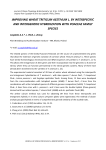Статьи журнала - Журнал стресс-физиологии и биохимии
Все статьи: 984
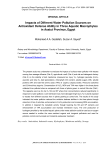
Статья научная
The present study was undertaken to evaluate the impacts of surface water pollution with wastes coming from sewage effluents (Site 2), agricultural runoff (Site 4) and oils and detergents factory (Site 3) on the stability of leaf membrane (measured as injury %), hydrogen peroxide (H 2O 2), ascorbic acid (Asc A), lipid peroxidation, chlorophyll (Chl) content, soluble sugars (SS), soluble proteins (SP) and total free amino acids (TAA) of Cyperus alopeucroides, Persicaria salicifolia and Echinochloa stagnina. Concentration of H 2O 2, MDA and TAA were higher in the three plants collected from polluted sites as compared with those of plants grown in control Nile site (Site1). The opposite was true for Asc A, SS and SP where their concentrations reduced significantly in response to water pollution. Leaf membrane was more damaged (high injury %) in plants exposed to wastes from different sources than in plants growing at control site. The results of this study indicated that water pollution reduced the oxidative defense abilities in the three plants through reduction of Asc A activities, enhancement of H 2O 2 production and increasing MDA accumulation. In addition it impaired the metabolic activity through lowering the SS and SP contents and enhancement of TAA accumulation and increase membrane injury. The over production of hydrogen peroxide by the studied aquatic plants under water pollution could be used as an oxygen source needed to oxidize the more resistant organic and inorganic pollutants and used for pollution control and municipal and industrial wastewater treatment.
Бесплатно
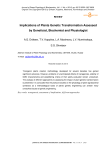
Implications of plants genetic transformation assessed by geneticist, biochemist and physiologist
Статья обзорная
Transgenic plants creation methodology developed for several decades has gained significant advances. However, problems of unanticipated effects of transgenosis, stability of GMO characteristics and establishing criteria of their safety evaluation remain unresolved. The analysis of different approaches to assessing the impact of plant genetic transformation is presented. It is concluded that the profound studies on the physiology of plant-agrobacterial symbiosis as a methodological basis of plants genetic engineering can answer many unresolved issues of genetic engineering.
Бесплатно
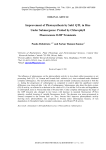
Статья научная
The influence of submergence on the photosynthetic activity in rice plants either possessing or not possessing Sub1 QTL i.e. Swarna and Swarna Sub1 cultivars (cv.) were evaluated under simulated complete submergence. The leaf photosynthetic rate and stomatal conductance decreased in both the cv. during the progression of submergence as compared to control plant but significant varietal differences was observed after 1 day (d) of submergence. Submergence also alters the photo-system (PS) II activity, as reflected in a decrease in the values of Fo, Fm and the Fv/Fm ratio and degradation of chlorophyll, more in Swarna than that of Swarna Sub1. Under complete submergence the shape of the OJIP transient also changed in rice leaves with decrease in maximal fluorescence (P=Fm) intensity, resulted lowering of variable fluorescence levels. The decrease was more pronounced in Swarna compared to the Swarna Sub1 cv. Thus, Swarna Sub1 improves photosynthetic activity showing more photosynthetic rate compared to Swarna under submergence because, of less degradation of chlorophyll, higher stomatal conductance, and efficient PS II activity.
Бесплатно
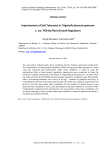
Improvement of salt tolerance in Trigonella foenum-graecum L. var. PEB by plant growth regulators
Статья научная
The crop yield is reduced under saline conditions and this hampers agricultural productivity. The incorporation of plant growth regulators (PGRs) during presoaking treatments in many crops has improved seed performance under saline conditions. In order to study the ameliorative effect of plant growth regulators, experiments were conducted to study the variation in organic constituents in the leaves of Trigonella foenum-graecum L. var.PEB, where the seeds were primed with different plant growth regulators and grown under NaCl salinity. After a pre-soaking treatment of six hours in 20 mg L -1 solutions of gibberllic acid (GA 3), 6-furfuryladenine (Kinetin) and benzyl adenine (BA), the seeds were allowed to germinate and grow for forty-five days under saline conditions. On the analysis of mature leaves, it was observed that chlorophyll a and b, total chlorophyll and protein showed an increase in PGR-treated plants compared to the untreated set. The accumulation of the stress metabolite such as proline and sugars, which increase under saline conditions, showed a significant decrease in the plants pretreated with PGRs.
Бесплатно
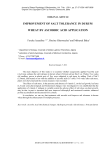
Improvement of salt tolerance in durum wheat by ascorbic acid application
Статья научная
The main objective of this study is to examine whether exogenously applied Ascorbic acid (AsA) may enhance the salt tolerance in durum wheat (Triticum durum Desf. var. Waha). Two weeks old seedling, grown in plastic pots of 1kg, were subjected to salt stress by adding 25ml of NaCl (150mm), and treated or not with the addition of ascorbic acid (0.7 mM). Two weeks after salt stress, plants were harvested and the various measures were recorded. The effects of salt stress, in the presence and absence of vitamin C, on the leaf growth, leaf area (LA) and some physiological and biochemical changes were investigated. It was established that the application of vitamin C mitigate to variable extent the adverse effect of salt stress on plant growth, may be due, in part, to increased leaf area, improved chlorophyll and carotenoid contents, enhanced proline accumulation and decreased H2O2 content. In conclusion, we can say that treatment with ascorbic acid improve salt tolerance in durum wheat through the enhancement of multiple processes.
Бесплатно
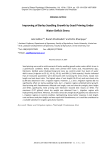
Improving of barley seedling growth by seed priming under water deficit stress
Статья научная
Seed priming was used to reinforcement of barley seedling growth under water deficit stress in a greenhouse condition. Barley seeds were primed with humic acid, Pseudomonas Spp., Marmarin, distilled water (hydropriming) and none (as control) under four levels of water deficit stress (irrigation at 20 (I 1), 40 (I 2), 60 (I 3) and 80% (I 4) field capacity). Results indicated that all measured parameters were decreased with increasing the stress levels, except root length and root-shoot ratio. The highest value of root length (18.42 cm) and root-shoot ratio (2.84) was obtained in the I 1 irrigation regime. However, I 2, I 3 and I 4 irrigation regimes did not significantly affect on barley seedling traits, but I 1 irrigation regime exhibited better growth. Seed priming with Pseudomonas affected root length, root and shoot dry weight, plant height and SPAD, significantly. Seed priming with Marmarin showed best results on SPAD. The maximum (0.37 g/plant) shoot dry weight was obtained from I 2 irrigation regime with hydropriming treatment. Whereas, the lowest shoot dry weight (0.14 g/plant) was observed in I 1 irrigation regimes in control condition. Hydropriming shows better response in root length, root and shoot and plant height and was equal with Pseudomonas, so it could be considered as a suitable substitute in organic agricultural systems.
Бесплатно
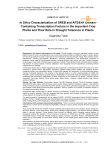
Статья научная
Background, the context and purpose of the study: Climate change is having a significant impact on crop plants around the world. As temperatures rise, some crops are becoming more difficult to grow in certain regions and are being replaced by other crops that are more tolerant of heat and drought. Plants have evolved various mechanisms, including physiological adaptations, structural modifications, and biochemical responses to withstand a wide range of environmental stresses, including drought, heat, salinity, and cold. Complex networks of genes play crucial roles in eliciting stress responses in plants. These genes encode a diverse array of proteins that function in various aspects of stress adaptation, from regulating hormone signalling to protecting cellular components from damage. Transcription factors act as master regulators of gene expression, controlling which genes are turned on or off in response to specific stimuli. Dehydration responsive element binding protein (DREB) and AP2/ERF domain-containing protein are transcription factors in plants that regulate the expression of stress-responsive genes involved in drought tolerance. The purpose of the present study is in silico characterization of DREB and AP2/ERF domain-containing transcription factors, identification of conserved motifs and phylogenetic analysis to understand the evolutionary relationships of these sequences in the important crop plants - Sorghum bicolor (Sorghum), Zea mays (Maize), Oryza sativa subsp. indica (Rice), Hordeum vulgare (Barley), and Triticum aestivum (Wheat). Results, the main findings: Transcription factors- F8V180 ( Sorghum bicolor ), C5XNL0 ( Sorghum bicolor ), A0A1D6FEN0 ( Zea mays ), A2WL19 ( Oryza sativa subsp. indica ), Q4ZGK0 ( Hordeum vulgare ) , and Q4U0C8 ( Triticum aestivum ) have a conserved AP2/ ERF domain, all show their subcellular localization in the nucleus and are involved in DNA binding and transcription regulation. There is variation in id position of AP2/ERF domain in the selected transcription factors. Phylogenetic data indicate that the relative amounts of evolutionary change have occurred since the proteins shared a common ancestor. Data also suggests that these proteins have evolved at different rates, indicating varying degrees of divergence among the proteins. The grand average of hydropathicity and pI values of DREB - AP2/ERF transcription factors F8V180 ( Sorghum bicolor ), C5XNL0 ( Sorghum bicolor ) and A0A1D6FEN0 ( Zea mays ) indicate that these are more stable and have better binding affinity to their target gene, thereby better transcription regulation. Conclusions, brief summary and potential implications: There is a need to extensively study stress tolerance mechanisms in plants and to increase the adaptability of plants to various abiotic stresses like heat, drought and salinity. Study reveal that DREB and AP2/ERF domain-containing transcription factors from Sorghum bicolor (Sorghum), Zea mays (Maize) , Oryza sativa subsp. indica (Rice), Hordeum vulgare (Barley) , and Triticum aestivum (Wheat) share a common ancestor. These proteins have evolved at different rates, indicating varying degrees of divergence among the proteins. Physico-chemical properties of DREB and AP2/ERF domain-containing transcription factors reveal that F8V180 ( Sorghum bicolor ), C5XNL0 ( Sorghum bicolor ), A0A1D6FEN0 ( Zea mays ) are the most stable and with better binding affinity to their target genes thereby better transcriptional regulation. Overexpression of DREB and AP2/ERF transcription factors in transgenic plants can be a promising strategy for enhancing plant tolerance to abiotic stresses (particularly drought and salinity) and improving crop productivity under challenging environmental conditions.
Бесплатно
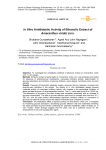
In vitro antidiabetic activity of ethanolic extract of Amaranthus viridis linn
Статья научная
Objective: To investigate the antidiabetic potential of ethanoilc extract of Amaranthus viridis Linn. in vitro assays. Methods: Ethanolic extract of aerial parts of Amaranthus viridis Linn. was extracted and tested for presence of phytochemical constituents, a-amylase inhibitory activity, determination of glucose adsorption and inhibition of glucose diffusion using dialysis membrane done by plant extracts. Results: Presence of Flavonoids, alkaloids, sugars, quinones, tannins, terpenes, coumarin and phenols.were identified in the extract. The results of in vitro antidiabetic assays showed moderate activity of a-amylase inhibitory activity with increase in the percentage inhibition of alpha amylase enzyme in a dose dependent manner. The IC50 value was found to be 155.60 ^g. The adsorption of glucose by the plant extract was increased remarkably with an increase in glucose concentration. The rate of glucose diffusion was found to increase with time from 30 -180 min, and the plant extract demonstrated significant inhibitory effects on movement of glucose into external solution across the dialysis membrane and compared to control. Conclusion: The antidiabetic effect of aqueous extract of Amaranthus viridis Linn. is mediated by increasing glucose adsorption, decreasing glucose diffusion rate and moderately inhibiting the alpha amylase enzyme thereby exhibiting the potential antidiabetic effect revealed by in vitro models. These findings suggest that the plant may be a potential source for the development of new oral hypoglycemic agent.
Бесплатно
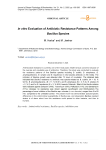
In vitro evaluation of antibiotic resistance patterns among Bacillus species
Статья научная
Antimicrobial resistance is currently one of the most public health serious concerns because of the overuse and unsuitable use of antibiotics. Therefore, this study was conducted to evaluate the resistance patterns of five Bacillus species including B. subtilis, B.atrophaeus, B. amyloliquefaciens, B. simplex and B. tequilensis in vitro towards antibiotic on NA media. The inhibition of Bacillus growth was detected after 72 hours of incubation. The obtained data indicated that Bacillus resistance to antibiotic was species-related as B. subtilis, (N = 19; % 94.74), B. amyloliquefaciens, (N = 11; % 90.91), and B. atrophaeus (N = 3; % 0), B. simplex (N = 2; % 0) and for B. tequilensis (N = 3; % 66.6) towards Cefazolin. Most of the Bacillus strains were resistant against Cefazolin (79%), Tobramycin (16%), Pefloxacin (11%), and Gentamycin (11%), whereas no resistance was shown against Levofloxacin and Nitrofurantoin. The percentage of zone inhibition of the Bacillus ssp. colonies (in mm diameter) ranged from 0 to 60 mm, compared to the untreated control. The present work has demonstrated species-specific differences in the antimicrobial susceptibility of Bacillus spp. and observation Bacillus resistant strains is of alarm about how this resistance could spread to other bacteria, and then to humans.
Бесплатно
![In vitro evaluation of antidiabetic potential of Vetiveria zizoniodes L. [Nash] root extracts In vitro evaluation of antidiabetic potential of Vetiveria zizoniodes L. [Nash] root extracts](/file/thumb/143182816/in-vitro-evaluation-of-antidiabetic-potential-of-vetiveria-zizoniodes-l-nash.png)
In vitro evaluation of antidiabetic potential of Vetiveria zizoniodes L. [Nash] root extracts
Статья научная
Diabetes mellitus is a chronic metabolic disorder caused by inherited or acquired deficiency in production of insulin by the pancreas, or by the ineffectiveness of the insulin produced. It is widely present in all parts of the world affecting nearly 15 % of the population and considered as one of the leading cause of death in humans. In recent years alternative treatment methods are being followed by the diabetic patients in order to avoid side effects of allopathic medicines. Many plant sources are being used to treat diabetes mellitus from time immemorial but all are not validated scientifically. Hence in the present study a commonly available drug source - Vetiveria zizanioides L. (Nash) belonging to the family Poaceae has been chosen and tested for its in vitro antidiabetic potential. Aqueous and ethanolic root extract of Vetiveria zizanioides L. (Nash) were prepared and evaluated for its in vitro antidiabetic potential. Preliminary phytochemical screening of plant extracts revealed the presence of saponin, terpenoid, alkaloid, coumarin, flavanoids, lignins, glycosides and Phenol. The extracts were studied for in vitro antidiabetic activity and its effect on inhibition of glucose diffusion, glycosylation of hemoglobin and glucose transport across yeast cells. From the extracts, ethanol extract exhibited potent inhibition of glucose diffusion, glycosylation of hemoglobin, glucose uptake by yeast cells, significant glucose adsorption capacity, uptake of glucose by rat hemi-diaphragm were found to be in a dose dependent manner. From the results of the study, it is inferred that, Vetiveria zizanioides L. (Nash) root ethanol extract possesses excellent antidiabetic activity compared to aqueous extract. However, these effects need to be confirmed using in vivo models and clinical trials for its effective utilization as therapeutic agent.
Бесплатно
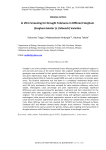
Статья научная
Drought is one of the complex environmental factors affecting growth and yield of sorghum in arid and semi-arid areas of the world. Sixteen elite sorghum ( Sorghum bicolor (L) Moench) genotypes were evaluated for their genetic potential to drought tolerance at callus induction and plant regeneration stage for drought tolerance. The non-ionic water soluble polymer polyethylene glycol (PEG) of molecular weight 6000 was used as osmoticum to simulate water stress. The factorial experiment was laid down in a completely randomized design which comprised of a combination of two factors (genotypes and five PEG stress level; 0, 0.5, 1.0, 1.5, and 2.0% (w/v) treatments). Data were recorded for callus induction efficiency, callus fresh weight, embryogenic callus percentage and plant regeneration percentage. Significant differences were observed among the genotypes, treatments and their interactions for the evaluated plant traits suggesting a great amount of variability for drought tolerance in sorghum. The correlation analysis also revealed strong and significant association between embryogenic callus percent and plant regeneration percent as well as between embryogenic callus percent and plant regeneration percent. By taking into consideration all the measured traits, Mann Whitney rank sum test revealed that 76T1#23 and Teshale followed by Meko, Gambella-1107 and Melkam showed better drought stress tolerance. Therefore they are recommended to be used as parents for genetic analysis, gene mapping and improvement of drought tolerance while Chelenko, Hormat and Raya appear to be drought sensitive.
Бесплатно
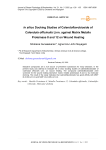
Статья научная
Bioactive compounds are a rich source of preventive substances for many diseases. In the present study was attempt to evaluate the in silico docking studies of calendoflavobioside of Calendula officinalis Linn. on wound healing. The compound calendoflavobioside were screened for the wound healing biomarker matrix metallo proteinases 8 and 12 by molecular docking. The result of the study indicates that calendoflavobioside has good affinity with MMP 8(-3.00kcal/mol) and MMP 12(-3.08kcal/mol).
Бесплатно

Статья научная
Background: Phytochemicals are the physiologically active substances found in plants. These phytochemicals which can be found in a variety of plant parts including leaves, flowers, seeds, bark, roots, and pulps, have been employed as direct therapeutic agents. The perennial herb Oenanthe javanica , sometimes called Java water dropwort, water celery, water dropwort, or Indian pennywort, is endemic to East Asia and is specifically utilized in traditional medicine and culinary arts.
Бесплатно
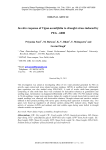
In-vitro response of Vigna aconitifolia to drought stress induced by PEG - 6000
Статья научная
This investigation was aimed at investigating effect of low water potential generated by PEG on growth, sugar content and stress related enzymes (catalase, GPOX) at seedling level. Additionally gene expression was also studied using SDS-PAGE. A total of twelve moth bean genotypes comprising of elite moth bean lines were evaluated for desiccation tolerance at germination and seedling stage. Germination was happened differentially at 8% PEG while 15% PEG induced wilting in 7d old seedlings. Longer roots and shoots, higher dry weight of root and shoots both in control and treated seedlings was observed with desiccation tolerance. Drought tolerant and sensitive varieties differed in their protein profiling with newer genes showing their expression in tolerant once. Two genes were found up regulated in all tolerant varieties during PEG induced stress. Higher basal activity of enzymes (GPOX and catalase) and total soluble sugar during water deficit in drought tolerant varieties was reported.
Бесплатно
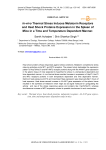
Статья научная
Heat shock proteins (Hsps) responses against stress conditions. Melatonin completes its stress relieving activities via its MT1 and MT2 receptors. The present study delineates the expression pattern of Hsp70/Hsc70 and MT1/MT2 receptor proteins along with the AANAT gene expression in the splenic tissue of mice subjected to hyperthermic stress in a temperature dependent and time dependent manner. In vivo thermal stress resulted increase in expression of Hsp70, Hsc70 and MT2 receptors proteins in both temperature dependent and time dependent manner. Optimum heat exposure at 430C and maximized Hsps expression was observed after 5 hours of heat exposure. Heat stress caused increase in AA-NAT gene expression of the splenic tissue resulted in the synthesis of melatonin which might act as signal molecule for upregulating the activity and rise of the stress responsive genes and proteins like: Hsp70/Hsc70, whereas simultaneous increase of MT2 expression shows its possible involvement in such mechanism.
Бесплатно
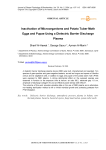
Статья научная
A dielectric barrier discharge plasma device (DBD) was built, characterized and operated. Ten species of gram-positive and gram-negative bacteria, as well as fungus and spores of Bacillus cereus and its vegetative cells, in addition to eggs and pupae of the potato tuber moth (PTM) were exposed to DBD plasma. A strong detrimental effect on the exposed species was observed in function to the exposure time at helium: air ratio 98:2, electrode gap 1.8 cm, amplitude of discharge voltage 6 kV and an effective power density 208 mW/cm3. The outcome of this work provides valuable data on the use of DBD plasma as an alternative non-heating sterilization method to kill or inhibit microbial growth and protecting potatoes from PTM infestation.
Бесплатно
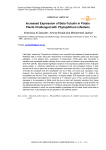
Increased expression of beta-tubulin in potato plants challenged with phytophthora infestans
Статья научная
Late blight, caused by Phytophthora infestans is an important foliar disease of potato worldwide. Relatively little is known about the mechanisms of interaction between potato and this fungal pathogen. In the present work, expression of beta-tubulin (TUB) gene was monitored in resistant and susceptible potato cultivars at four early points of infection using quantitative real-time PCR (qPCR). Data showed significant variation in the expression patterns of the TUB gene during potato- P. infestans interactions as compared to the non-inoculated controls. It also shows that β- tubulin gene has a higher expression and faster induction in the resistant cultivar (0.9-fold) as compared with the susceptible one (0.11-fold), 24 hours post inoculation (hpi). However, the maximum expressions were 1.85 -folds in the resistant, and 1.3 -folds in the susceptible one 48 and 72 hpi, respectively. Increased potato TUB expression could be due to plant cytoskeleton rearrangement in response to P. infestans up to 72 hpi, and the subsequent decrease in its expression at 96hpi could be due to plant cell disruption resulting from tissue damage during necrosis. The information obtained from this study highlights crucial remarks into the signaling pathway that accounts for TUB gene expression changes elicited during potato- P. infestans interactions, which can provide testable hypotheses that will need direct future tests to determine how TUB changes may be specified in the defense system.
Бесплатно
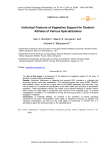
Individual features of vegetative support for student-athletes of various specializations
Статья научная
The aim of this paper is assessment of the features of vegetative support of the body of students of various sports specialization. Results: Significant differences in statistical and spectral HRV indicators in volleyball and swimming groups have been established. The volleyball players had lower SDNN, RMSSD, total spectrum power, as well as a higher level of the pNN50 parameter and heart rate. They have a tendency to increase the centralization of the heart rhythm and activation of sympathetic regulation. These assumptions confirm the values of the spectral analysis of cardiac rhythm, which shows the initial stage of overtraining and overwork in the volleyball group. To prevent maladaptation conditions, it is advisable to correct the training process in a group of students engaged in volleyball. Conclusion: In volleyball athletes, an increase in the activation of central regulatory mechanisms has been demonstrated, which leads to impaired functioning of adaptive and regulatory mechanisms, as well as to the initial stage of overtraining. To prevent this, it is advisable to adjust the training process in the volleyball group.
Бесплатно

Статья научная
The effect of 4-hydroxybenzoic acid (4-HBA) on resistance of coleoptiles of 4-day-old etiolated seedlings of wheat (Triticum aestivum L., cv. Elegiya) to damaging heating (10 min at 43°C) and possible dependence of this effect on changes in the activities of enzymes producing and scavenging reactive oxygen species (ROS) were investigated. Treatment of coleoptiles with 10 µM 4-HBA resulted in enhancing of superoxide anion-radical generation and maintaining of hydrogen peroxide content there in. Increasing of the rate of ROS production was significantly suppressed by inhibitors of NADPH oxidase (α-naphthol) and peroxidase (salicylhydroxamic acid). Under the influence of 4-HBA the activities of superoxide dismutase and apoplastic forms of peroxidase were increased. The activity of oxalate oxidase and catalase has not changed. Exogenous 4-HBA improved coleoptiles heat resistance and its effects were comparable with the influence of salicylic acid. Antioxidant agent BHT (butylhydroxytoluene), inhibitors of NADPH oxidase and peroxidase significantly reduced the increasing of wheat coleoptiles heat resistance, caused by 4-HBA action. It was concluded that 4-HBA influence on coleoptiles heat resistance is realized with the ROS mediation.
Бесплатно

